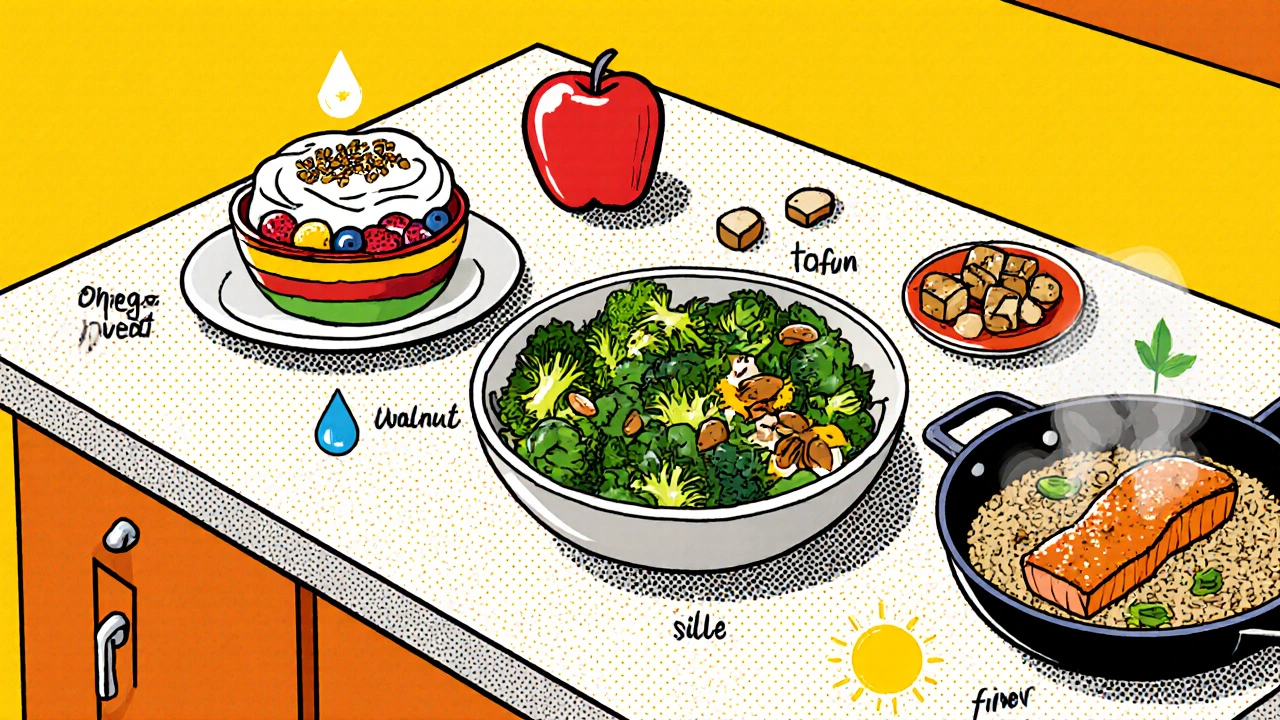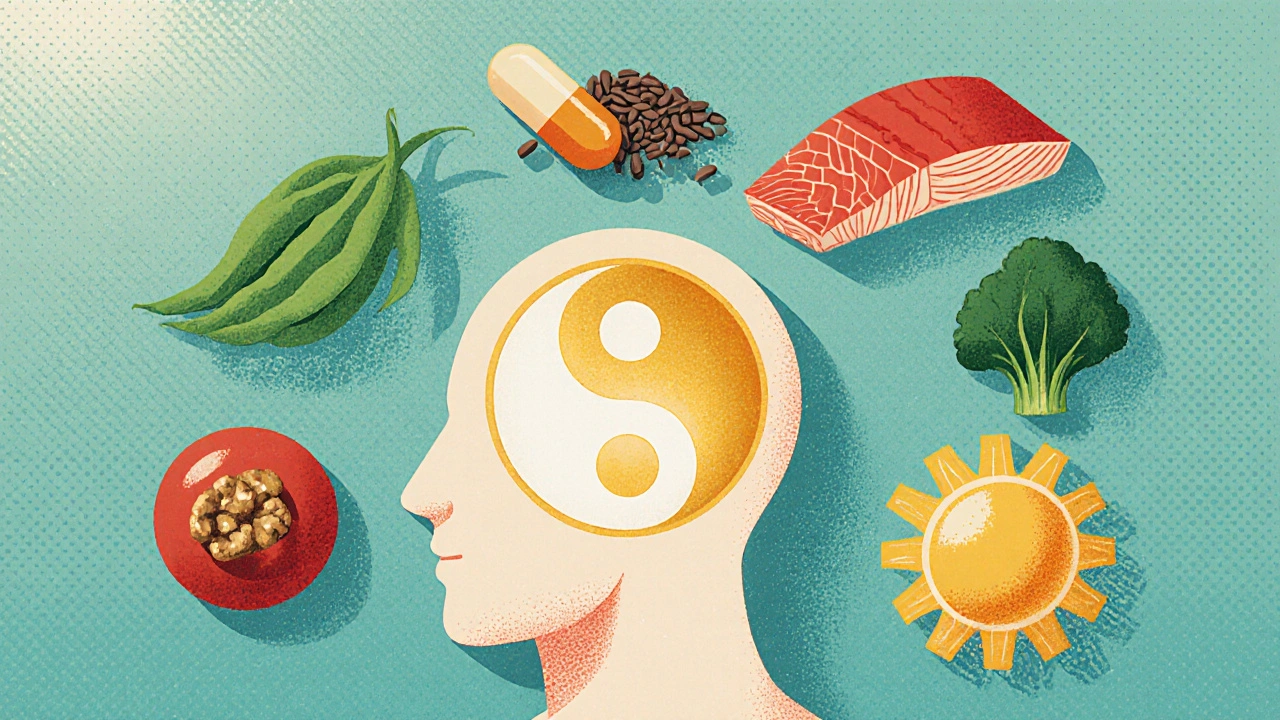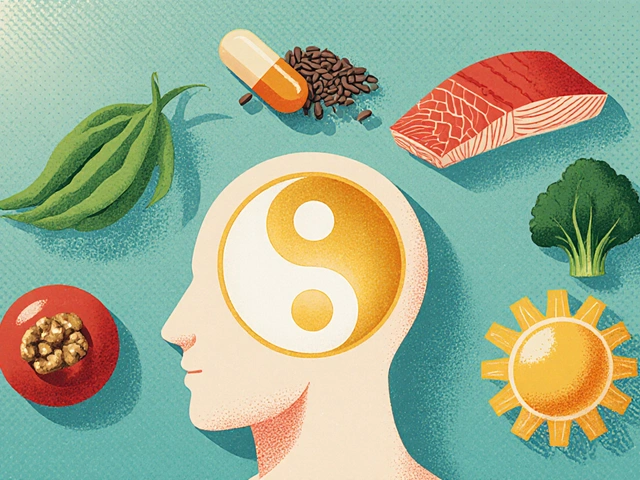Estradiol Balance Nutrition Tracker
Nutrient Tracker
Enter your daily intake of key nutrients for estradiol balance
Daily Recommendations
Aim for these nutrient levels to support balanced estradiol
Your Balance Assessment
When it comes to hormone health, Estradiol is the primary form of estrogen in both men and women, playing a crucial role in reproductive function, bone density, and mood regulation. Keeping its levels in the optimal range isn’t just about medication-what you eat can tip the balance one way or the other. This guide shows how to healthy estradiol levels using everyday foods and smart nutrition habits.
Key Takeaways
- Phytoestrogen‑rich foods gently modulate estradiol without causing spikes.
- Omega‑3 fatty acids, vitamin D, and magnesium support the enzymatic pathways that create and break down estradiol.
- High‑fiber, low‑sugar diets help the body excrete excess estrogen.
- Stress‑reduction and regular movement are as important as food choices.
- Track your diet and symptoms; adjust gradually and consult a professional.
Understanding Estradiol
Estradiol (E2) is the most potent estrogen in the bloodstream. In women, it peaks during the follicular phase of the menstrual cycle and drops after menopause. Men produce smaller amounts, but estradiol still influences libido, bone health, and cardiovascular function. The body constantly balances production, conversion, and elimination of estradiol through the liver, kidneys, and gut. Disruptions-whether from stress, poor diet, or health conditions-can push levels too high (leading to weight gain, mood swings, and fibroids) or too low (causing bone loss, hot flashes, and low libido).
How Diet Directly Affects Estradiol
Food impacts estradiol in three main ways: providing building blocks for hormone synthesis, influencing enzymes that metabolize estrogen, and altering the gut microbiome that recycles or discards excess hormones. By choosing the right nutrients, you can support a steady, healthy estradiol curve.
Phytoestrogens - Gentle Hormone Modulators
Phytoestrogens are plant‑derived compounds that bind to estrogen receptors, producing a mild estrogenic or anti‑estrogenic effect depending on the body’s own hormone levels. When your native estradiol is low, phytoestrogens act like a light supplement; when estradiol is high, they can block stronger signals, helping keep the overall activity balanced.
Soy Isoflavones - A Specific Phytoestrogen
Soy isoflavones (genistein and daidzein) are among the most studied phytoestrogens. A cup of boiled edamame delivers roughly 30 mg of isoflavones, enough to produce a modest serum effect without triggering hormonal spikes. Regular soy intake has been linked to smoother menstrual cycles and reduced menopausal symptoms.
Flaxseed Lignans - Another Natural Ally
Ground flaxseed supplies lignans, another class of phytoestrogens. One tablespoon offers about 0.3 mg of lignans, which the gut bacteria convert into enterolactone-a molecule that mimics weak estrogen. Adding 1‑2 tablespoons of ground flaxseed to smoothies or oatmeal supports estrogen balance while also providing omega‑3 fats.

Omega‑3 Fatty Acids - Inflammation Control
Omega‑3 fatty acids are polyunsaturated fats that reduce inflammation and improve cell‑membrane fluidity, essential for hormone receptor function. Chronic inflammation can push the body to produce more estradiol as a protective response, which may compound imbalances. Fatty fish (salmon, mackerel), walnuts, and chia seeds supply EPA and DHA, the most effective omega‑3 forms for hormone health.
Vitamin D - The Sunshine Hormone
Vitamin D is a fat‑soluble vitamin that acts as a hormone, influencing estrogen synthesis and receptor sensitivity. Low vitamin D levels are associated with higher estradiol turnover and irregular menstrual patterns. Aim for 800-1,000 IU daily from fortified foods, oily fish, or safe sun exposure.
Magnesium - Enzyme Cofactor for Hormone Metabolism
Magnesium supports over 300 enzymatic reactions, including those that convert estradiol into its inactive metabolites. Deficiency can slow clearance, leaving more active hormone in circulation. Dark leafy greens, pumpkin seeds, and black beans provide 100‑300 mg per serving.
Cruciferous Vegetables - Estrogen Detoxifiers
Cruciferous vegetables (broccoli, cauliflower, Brussels sprouts, kale) contain indole‑3‑carbinol (I3C) and sulforaphane, compounds that shift estrogen metabolism toward safer pathways (2‑hydroxy estradiol) rather than the more proliferative 16‑alpha‑hydroxy form. Eating at least two servings daily supports liver detoxification of excess estradiol.
Fiber - The Unsung Excretion Helper
Fiber binds to estrogen in the intestines and carries it out of the body via stool. Soluble fiber (oats, apples, legumes) is especially effective. Aim for 25‑30 g of total fiber each day to boost estrogen elimination without compromising gut health.
Practical Daily Food List
- Breakfast: Greek yogurt + 1 tbsp ground flaxseed + berries (high fiber, lignans).
- Snack: Handful of walnuts (omega‑3) or a piece of fruit.
- Lunch: Mixed leafy salad with kale, broccoli florets, pumpkin seeds, olive oil, and a serving of grilled salmon (vitamin D + omega‑3).
- Afternoon: Edamame or a small soy milk smoothie (soy isoflavones).
- Dinner: Stir‑fried tofu with Brussels sprouts and quinoa, seasoned with turmeric (anti‑inflammatory).
- Evening: Herbal tea (green tea for additional antioxidants) and a square of dark chocolate (magnesium).
Food Comparison Table
| Food Group | Primary Nutrient | Typical Serving | Benefit for Estradiol |
|---|---|---|---|
| Phytoestrogen‑rich | Soy isoflavones | 1 cup edamame | Gentle receptor modulation |
| Omega‑3 rich | EPA/DHA | 100 g salmon | Reduces inflammatory drive for excess estradiol |
| Vitamin D sources | Vitamin D3 | 200 ml fortified milk | Supports estrogen synthesis & receptor sensitivity |
Checklist for a Hormone‑Friendly Day
- Start the day with fiber‑rich breakfast (30 g total by lunch).
- Include at least one phytoestrogen source (soy, flax, lentils).
- Consume omega‑3 fats daily (fish, walnuts, chia).
- Get 800‑1,000 IU vitamin D via food or sunlight.
- Add a serving of cruciferous veg at lunch or dinner.
- Stay hydrated (2-2.5 L water) to aid kidney elimination.
- Limit processed sugars and refined carbs (< 10 % of total calories).
- Practice stress‑relief (10‑min breathing, walk, or yoga) to keep cortisol low.
Common Pitfalls to Avoid
Even with the best food plan, certain habits can sabotage estradiol balance:
- Excess alcohol impairs liver detox pathways, allowing estrogen to linger.
- High‑glycemic snacks spike insulin, which can increase aromatase activity (the enzyme that converts testosterone to estradiol).
- Chronic stress elevates cortisol, which interferes with the hypothalamic‑pituitary‑ovarian axis.
- Relying on low‑fat, high‑processed‑food diets removes essential fats needed for hormone synthesis.
When to Seek Professional Help
If you notice persistent symptoms-irregular periods, unexplained weight gain, mood swings, or low libido-consider a blood test to check estradiol, progesterone, and related markers. A registered dietitian or endocrinologist can tailor the nutrition plan to your specific hormonal profile.
Next Steps
- Log your meals for a week using a simple spreadsheet or app.
- Calculate fiber, omega‑3, and phytoestrogen intake; aim for the targets listed above.
- Introduce one new estradiol‑supportive food each week to avoid overwhelm.
- Re‑assess symptoms after four weeks; adjust portions or add supplements (e.g., magnesium citrate) if needed.
- Schedule a check‑up with your healthcare provider to evaluate hormone levels and confirm the plan is working.
Frequently Asked Questions
Can men benefit from a phytoestrogen‑rich diet?
Yes. Men produce small amounts of estradiol that are vital for bone health and cardiovascular function. Moderate phytoestrogen intake can help keep those levels stable without causing feminizing effects.
How much soy is safe to eat each day?
Most research supports up to 2 cups of cooked soy (about 30‑40 g protein) daily for healthy adults. This provides enough isoflavones for hormonal balance without adverse effects.
Do I need a supplement for vitamin D?
If you get limited sun exposure or have dietary restrictions, a 800‑1,000 IU vitamin D3 supplement is a reliable way to meet the target.
What role does gut health play in estrogen metabolism?
Beneficial bacteria convert estrogen conjugates into inactive forms that are excreted. A diet rich in fiber and fermented foods nurtures this microbiome, helping the body clear excess estradiol.
Are there any foods that raise estradiol too much?
Very high‑dose soy products (like soy protein powders) can push estradiol up in sensitive individuals. Balance is key-use whole‑food sources rather than mega‑doses.



Kajal Gupta
October 23, 2025 AT 15:50Wow, this rundown is like a rainbow of food hacks for hormone health! I love how you mixed the science with real‑world meals – makes it easy to slip the goodies into my daily routine. The flaxseed tip is my new morning ritual, and the cruciferous veg reminder saved my lunch prep.
Zachary Blackwell
October 28, 2025 AT 20:12People don’t tell you that the pharma giants are pushing synthetic estrogen pills to make us buy their meds, while they hide the power of simple foods. This guide is a silent rebellion against that hidden agenda.
prithi mallick
November 3, 2025 AT 00:33Reading through the list felt like a meditation on balance, each food a tiny prayer for harmony. The way you linked fiber to estrogen excretion really resonated with my own journey.
Even a small typo here and there doesnt matter when the heart is in the right place.
Michaela Dixon
November 8, 2025 AT 04:55I have been digging into the science behind estradiol for months and this article stitches everything together in a way that feels natural and vivid The idea that phytoestrogens act like gentle dimmers for our internal light is fascinating It reminds me of adjusting a lamp rather than flipping a switch The list of omega‑3 sources reads like a sailor’s catalog of treasures from the sea and the forest Each bite of salmon or walnut becomes a tiny anti‑inflammatory shield that calms the hormonal storm You can almost hear the cells sigh as membranes become more fluid and receptors open with ease The vitamin D section feels like a sunrise invitation to step outside and let the skin soak up the sky The suggestion to log meals for a week is pure practicality it turns abstract numbers into personal stories The emphasis on cruciferous veggies turning estrogen metabolism toward safer pathways is a biochemical dance I never imagined I love how the author pairs science with simple recipes like tofu stir‑fry with Brussels sprouts The fiber advice reads like a quiet whisper that says keep things moving along the gut highway The practical daily food list reads like a menu for a balanced life It is not a restrictive diet but a generous palette of flavors The tone stays supportive not preachy It feels like a friend sharing a secret toolbox for hormone health The final checklist is a clear roadmap that anyone can follow.
Dan Danuts
November 13, 2025 AT 09:17Kickstart your day with flaxseed and feel the boost!
Dante Russello
November 18, 2025 AT 13:39Absolutely, Dan! Adding those omega‑3 rich nuts in the mid‑morning not only fuels your brain but also supports hormone pathways, and a quick walk after lunch can further enhance circulation, helping nutrients reach every cell efficiently.
James Gray
November 23, 2025 AT 18:01Yo bro, this guide is lit. I started throwin in edamame with my lunch and felt a real smooth vibe. The flaxseed tip is dope, i even add it to my chai. Keep spreadin the word, fam.
Scott Ring
November 28, 2025 AT 22:23Great to hear you’re giving it a try, James. The balance between flavor and function is key, and your casual approach makes it accessible to many.
Shubhi Sahni
December 4, 2025 AT 02:44Indeed, Shubhi, the recommendation to incorporate cruciferous vegetables daily, such as broccoli and kale, provides indole‑3‑carbinol which steers estrogen metabolism toward less proliferative forms; moreover, the emphasis on adequate hydration supports renal clearance of excess hormones, creating a comprehensive strategy for hormonal equilibrium.
Danielle St. Marie
December 9, 2025 AT 07:06Honestly, anyone who ignores these simple food tricks is basically sabotaging their own health 😂🇺🇸. The article shows that you don’t need fancy supplements when the answer is right in your pantry 🍽️.